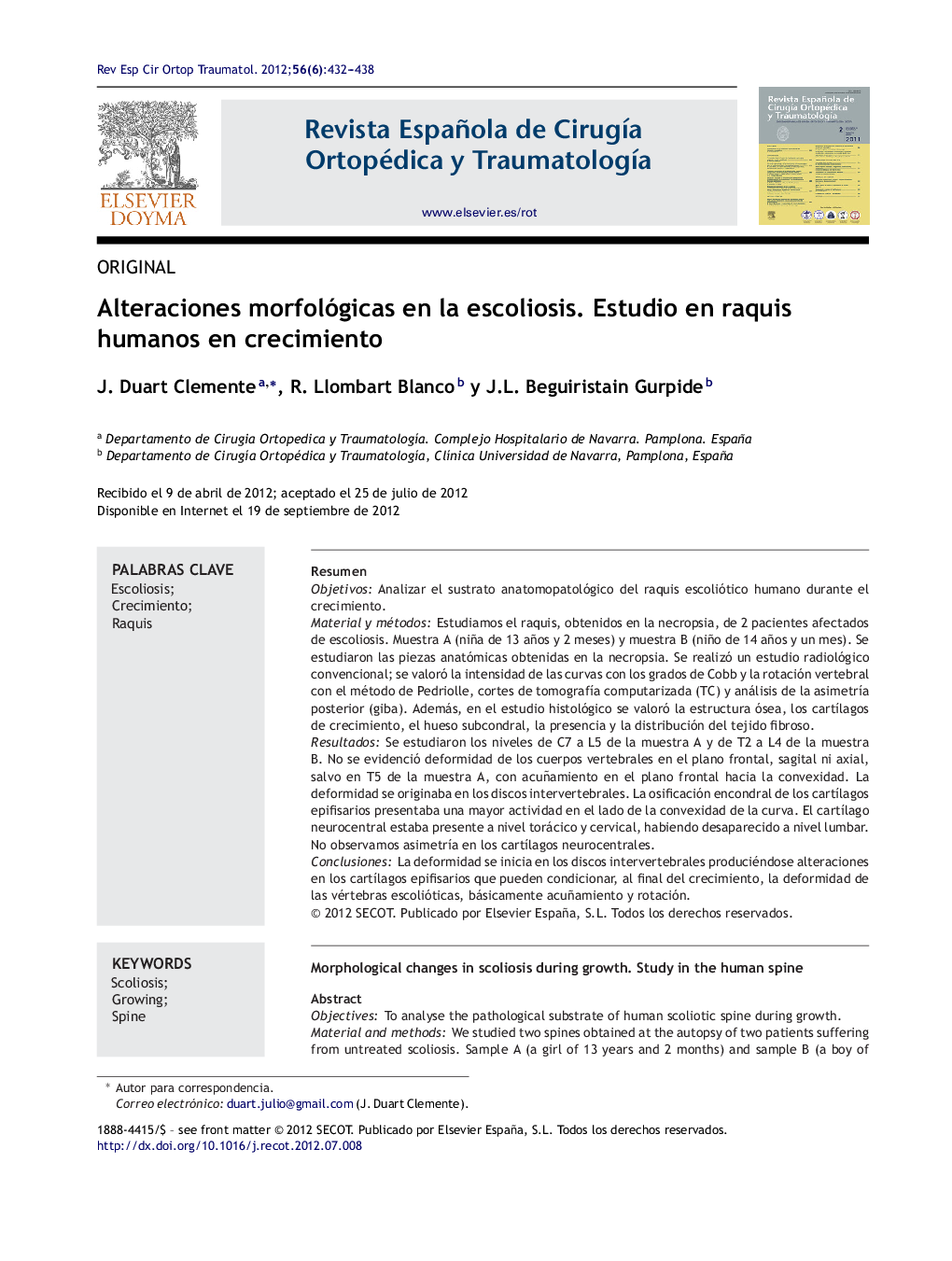| کد مقاله | کد نشریه | سال انتشار | مقاله انگلیسی | نسخه تمام متن |
|---|---|---|---|---|
| 4086387 | 1267949 | 2012 | 7 صفحه PDF | دانلود رایگان |

ResumenObjetivosAnalizar el sustrato anatomopatológico del raquis escoliótico humano durante el crecimiento.Material y métodosEstudiamos el raquis, obtenidos en la necropsia, de 2 pacientes afectados de escoliosis. Muestra A (niña de 13 años y 2 meses) y muestra B (niño de 14 años y un mes). Se estudiaron las piezas anatómicas obtenidas en la necropsia. Se realizó un estudio radiológico convencional; se valoró la intensidad de las curvas con los grados de Cobb y la rotación vertebral con el método de Pedriolle, cortes de tomografía computarizada (TC) y análisis de la asimetría posterior (giba). Además, en el estudio histológico se valoró la estructura ósea, los cartílagos de crecimiento, el hueso subcondral, la presencia y la distribución del tejido fibroso.ResultadosSe estudiaron los niveles de C7 a L5 de la muestra A y de T2 a L4 de la muestra B. No se evidenció deformidad de los cuerpos vertebrales en el plano frontal, sagital ni axial, salvo en T5 de la muestra A, con acuñamiento en el plano frontal hacia la convexidad. La deformidad se originaba en los discos intervertebrales. La osificación encondral de los cartílagos epifisarios presentaba una mayor actividad en el lado de la convexidad de la curva. El cartílago neurocentral estaba presente a nivel torácico y cervical, habiendo desaparecido a nivel lumbar. No observamos asimetría en los cartílagos neurocentrales.ConclusionesLa deformidad se inicia en los discos intervertebrales produciéndose alteraciones en los cartílagos epifisarios que pueden condicionar, al final del crecimiento, la deformidad de las vértebras escolióticas, básicamente acuñamiento y rotación.
ObjectivesTo analyse the pathological substrate of human scoliotic spine during growth.Material and methodsWe studied two spines obtained at the autopsy of two patients suffering from untreated scoliosis. Sample A (a girl of 13 years and 2 months) and sample B (a boy of 14 years and one month). On the conventional radiological study the curves were measured using the method of Cobb, and the vertebral rotation with the Pedriolle method. A CT scan and analysis of the posterior asymmetry were also performed. The bone structure, growth plate, subchondral bone were evaluated in the histological study, as well as the presence and distribution of fibrous tissue.ResultsLevels from C7 to L5 were studied in sample A, and levels from T2 to L4 in sample B. There was no evidence of vertebral deformity in the frontal, sagittal or axial planes, except for T5 in sample A, where wedging into the concavity in the frontal plane was observed. The deformity originated in the intervertebral discs. Endochondral ossification of the epiphyseal cartilage showed increased activity on the side of the convexity of the curve. Neurocentral cartilage was present at thoracic and cervical level, having disappeared at lumbar level. No asymmetry was observed in the neurocentral cartilage.ConclusionsThe deformity begins in the intervertebral discs, producing distortions in the epiphyseal cartilage. Those changes may influence the end of growth and therefore the deformity of the scoliotic vertebrae, basically resulting in wedging and rotation of the vertebrae.
Journal: Revista Española de Cirugía Ortopédica y Traumatología - Volume 56, Issue 6, November–December 2012, Pages 432–438